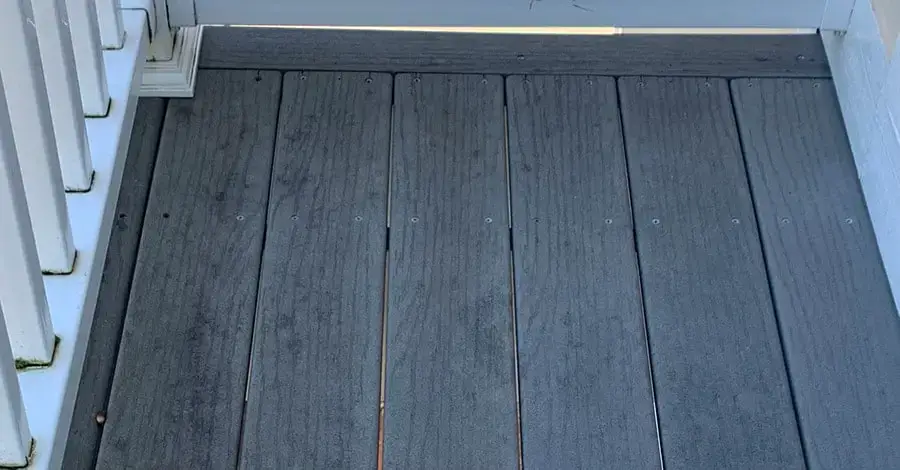Can You Paint Or Stain Composite Decks (TREX)

Do you have a discolored composite deck? Maybe you just painted your house recently, and now you want your deck to match your house’s color pattern. Whatever the case, you might be wondering, can you paint or stain Trex synthetic (composite) decking?
You can paint or stain composite decking. But make sure that it is uncapped. Otherwise, the paint will not stick to the deck surface.
There are lots of factors involved with painting or staining composite decks. Through this article, I will explain the advantages and disadvantages of painting or staining composite decks, which composite materials can be refinished, how long these stains or paints will last, and many more. So, let’s begin!
Painting or Staining Composite Decks
Composite decking, also known as wood-polymer composite, or synthetic decking, has become the first choice for outdoor spaces. Synthetic decking is a composite of wood fiber and plastic. They are not only environment friendly but also are an excellent alternative to wood decking material.
Advantages of Composite Decking
There are many reasons why synthetic decks have become very popular in the past few decades.
- The first one is its durability. Composite decks have a very long lifespan. Its durability makes it the perfect material for outdoor spaces.
- It is rot-proof, won’t crack or warp even when exposed to a very harsh environment.
- Other than its durability, composite decking also requires very low maintenance. You can clean it very easily.
- Composite decking is made from recycled wood fibers and plastics. So, they have no environmental impact, making it very eco-friendly.
- You can get composite decking in many shades and colors. Some even look and feel like real wood, and you will not tell the difference.
Disadvantages of Composite Decking
Although they are very durable, with time, their color will begin to fade. Many reasons cause this deterioration in color, like the moisture in the air, usage, etc. But you can easily restore the shades of your composite deck by painting or staining it. Or you can do it to achieve a custom color.
The first thing to remember here, painting or staining will only restore the appearance of your deck. But it will not necessarily provide additional protection, nor will it extend the lifespan of your composite deck.
What type of paint or stain that you can use on your composite decking depends on its brand and the materials it is made from? But in most cases, the stains and paints that you can use for wood are also applicable for synthetic decking. And it is recommended that you only use stain or paint made for a walking surface.
Both painting or staining are good options to restore the appearance of composite decking. But staining is mostly suitable for composite decks that are only a few years old. It gives them a natural woody look. And if you want your deck to look colorful, you can paint it too. Paints last longer than stains. Also, they are much easier to maintain compared to stains.
Which Composite Materials Can (and Can’t) Be Refinished?
Older composite decking that is made by combining plastic and wood fiber uniformly can be stained or painted. However, “Capped” composite decking can’t be painted or stained.
The construction of Capped composite decking is almost similar to older generation decking. Composites all have an inner core that is a composite of plastics and wood fibers. But in the case of capped composite decking, the inner core is covered with a PVC shell. This shell provides extra protection to the inner composite core from the outside environment.
Due to this PVC shell, paints or stains can’t stick to the capped composite decking. As a result, this type of composite decking can’t be refinished.
Things to Consider Before Painting or Staining Composite Decking
Before you start painting or staining your composite decking, there are lots of things you need to consider first. These are given below:
● The age of the composite decking
Age is important. As composite decking ages, its color starts to fade. And if your decking is at the end of its lifespan, you might want to replace it rather than refinishing it. Most of the composite decking has a lifespan of roughly twenty-five years. And if your decking is more than twenty years old, replacing it might be a good idea.
● Choose the paint or stain carefully
One of the main reasons for painting or staining composite decking is to achieve a custom color to match your house. Stains and paints for composite decking are available in many colors. Choose a color that is suitable for you. Before you apply the stain or paint to your deck, first apply it on a small piece of composite decking to see how it looks.
Also, always choose high-quality paints and stains. They might be a bit costly, but they will most probably last longer, which justifies their extra cost. Choose paints and stains that provide UV ray protection to your decking. You can also look for stains that contain zinc. Zinc resists the growth of molds and prevents discoloration.
You can also follow your composite decking manufacturer’s recommendation for choosing a paint or stain for your deck.
● Clean the surface thoroughly
Before applying paints or stains to your composite decking, clean the deck’s surface thoroughly. Use a composite deck cleaner or a scrub brush to get rid of all the mildew, dirt, mold from the composite decking surface.
● Prepare the Deck Surface
Once you have got rid of all the molds, dirt from the composite decking surface, you have to prepare the surface so that paints or stains can stick to it properly. Sand the surface using 220 or 240 grit sandpapers. But remember not to overdo it. Or else you might damage your deck.
After sanding, get rid of all the dust and apply primer. Acrylic latex-based primers are best for composite decking. They increase the durability of the stain or paint.
● Consider the Weather Condition
Before painting or staining your composite deck, always consider the weather condition. Moisture and rain are the worst enemies of your composite deck. If there is a chance of rain or fog within the next few days, or if the weather is too humid, it is recommended that you should avoid staining or painting your composite deck in such weather conditions.
Also, never apply paints or stains under direct sunlight. This will cause the paint or stain to dry faster and create lap marks on the composite deck’s surface.
How Long Will Paint or Staining Last
There is no accurate answer to this question. Many factors determine how long paint or stain will last after applying to the composite deck. Some of these factors are- the paint or stain type, the weather condition, how frequently you will use the deck, etc.
Considering everything is in ideal condition, paints can last up to ten years. And as mentioned before, stains have a shorter lifespan compared to paints. Typically stains last about one year on average. However, several stain products can last two years or more.
Conclusion
Composite decks are a bit costly, but they have a very long lifespan. At the same time, they do not require that much maintenance work. However, as they age, their colors will start to fade. In that case, you might want to paint or stain them to restore their appearance.
DISCLAIMER: The content published on HomeInspectionInsider.com is not professional advice. You should consult with a licensed professional and check local permit requirements before starting any project.
This article is posted with permission and was written by Hubert Miles from homeinspectioninsider.com Visit his page for more useful blogs!
